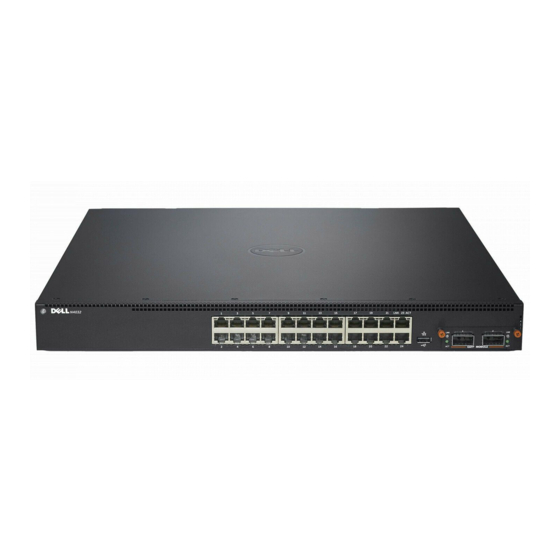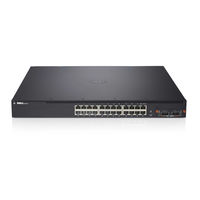
Dell Networking N4032 Manuals
Manuals and User Guides for Dell Networking N4032. We have 6 Dell Networking N4032 manuals available for free PDF download: Configuration Manual, Getting Started Manual, Reference Manual
Dell Networking N4032 Configuration Manual (1460 pages)
stackable Layer 2 and 3 switches
Table of Contents
-
-
-
Log Messages57
-
Sflow59
-
-
Ssh/Ssl64
-
-
-
Voice VLAN78
-
Guest VLAN78
-
Double Vlans78
-
-
VLAN Routing82
-
-
-
Ipv6 Routes85
-
Ospfv385
-
Dhcpv685
-
-
-
IGMP Proxy89
-
-
-
-
-
-
Front Panel115
-
N4000 Back Panel119
-
LED Definitions121
-
-
-
-
Administrator127
-
Defining Fields132
-
-
-
-
-
-
-
-
Stack Summary185
-
NSF Summary190
-
-
-
-
AAA Overview207
-
Methods208
-
Access Lines209
-
-
Authentication211
-
Authorization212
-
Accounting214
-
-
-
-
Method Lists239
-
-
-
-
Information243
-
-
System Health251
-
System Resources252
-
RAM Log258
-
Log File259
-
Syslog Server259
-
-
-
-
CLI Banner290
-
Clock292
-
SNTP Server296
-
Slot Summary302
-
Supported Cards303
-
-
-
SNMP Overview323
-
What Is SNMP323
-
-
-
Communities335
-
Trap Flags340
-
Trap Log343
-
-
-
-
-
File System367
-
Active Images368
-
USB Flash Drive369
-
File Download370
-
File Upload372
-
Copy Files374
-
-
-
-
-
-
-
GVRP Statistics421
-
EAP Statistics422
-
Counter Summary424
-
RMON Statistics426
-
RMON Event Log432
-
RMON Alarms433
-
Port Statistics435
-
LAG Statistics436
-
Port Mirroring437
-
-
Configuring RMON441
-
-
Configuring RMON449
-
-
-
-
Port Overview477
-
-
-
Security503
-
Captive Portal543
-
-
-
ACL Overview583
-
-
Overview594
-
Limitations596
-
Examples598
-
-
-
-
VLAN Overview645
-
Switchport Modes648
-
VLAN Tagging649
-
Gvrp650
-
Voice VLAN652
-
Private Vlans654
-
-
-
Creating a VLAN682
-
Configuring GVRP695
-
-
-
-
STP Overview715
-
Rstp-Pv724
-
-
STP LAG Settings740
-
MSTP Settings743
-
-
-
-
ISDP Cache Table766
-
ISDP Statistics768
-
LLDP Statistics771
-
LLDP Connections772
-
-
Configuring ISDP782
-
Configuring LLDP782
-
Advertisement
Dell Networking N4032 Getting Started Manual (378 pages)
highly scalable, non-stop networking switches for campus aggregation and core switching 10 GbE deployments
Table of Contents
-
Features7
-
System Leds12
-
Locator Led13
-
Installation14
-
Next Steps29
-
硬體概覽62
-
擴充槽64
-
Uart 介面64
-
系統 Led65
-
現場準備67
-
打開交換器包裝67
-
對交換器進行機架安裝68
-
啟動和設定交換器74
-
將交換器連接至終端機75
-
開機交換器76
-
進行初始組態76
-
Introduction87
-
Installation94
-
Du Commutateur102
-
Einführung117
-
Vorderseite119
-
System-Leds122
-
Installation124
-
Auspacken125
-
Des Switches132
-
Beispielsitzung136
-
Nächste Schritte141
-
Pendahuluan147
-
Fitur147
-
Panel Depan149
-
Slot Ekspansi150
-
Antarmuka UART151
-
LED Sistem152
-
Instalasi154
-
Penyiapan Lokasi154
-
Isi Kemasan154
-
Switch162
-
Mem-Boot Switch164
-
Contoh Sesi166
-
はじめに177
-
ハードウェアの概要178
-
Sfp180
-
Uart181
-
Led182
-
設置184
-
Dell Readyrails187
-
하드웨어 개요206
-
전면 패널207
-
확장 슬롯208
Advertisement
Dell Networking N4032 Getting Started Manual (60 pages)
Networking N4000 Series Switch
Table of Contents
-
-
Features7
-
Dell Networking N4032 Configuration Manual (17 pages)
Switch Configuration Guide for EqualLogic SANs
Table of Contents
Dell Networking N4032 Reference Manual (17 pages)
Expansion Modules for Dell Networking Switches
Table of Contents
Advertisement





